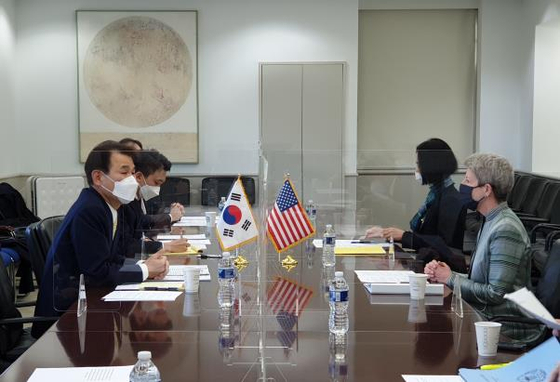
Ambassador Eun-bo Chung (left) and US representative Donna Welton are engaged in defense negotiations. Provided by the Ministry of Foreign Affairs
South Korea and the United States announced on the 7th (local time) that they have concluded negotiations on the Special Agreement on the Sharing of Defense Costs (SMA) between the United States and Korea for more than a year over the issue of the cost of stationing US forces in Korea.
The two sides did not announce specific agreements such as the rate of increase in the share of the Korean side or the contract period, but the foreign press quoted a source and said that the new agreement will continue until 2026 and that Korea will increase the share.
The Korean Ministry of Foreign Affairs said in a press release on the day that “the representatives of the two countries negotiated the 11th Korea-US SMA based on discussions, and as a result, a principled agreement was reached.”
The Ministry of Foreign Affairs said, “The government will contribute to strengthening the ROK-US alliance and the combined defense posture, which is the core axis of peace and prosperity on the Korean Peninsula and in Northeast Asia, through the conclusion of an agreement as soon as possible.”
The U.S. State Department also announced that it reached a principle agreement in the negotiations for sharing defense costs between Korea and the United States.
The Wall Street Journal (WSJ) cited diplomatic sources, saying, “The new agreement will remain until 2026,” saying that the ROK-US agreed to a five-year agreement, and that Korea decided to increase its share. CNN recently reported that there is a possibility that the ROK and the US will agree to a multi-year contract that will increase the defense cost share by 13%.
At the last face-to-face meeting held in Los Angeles (LA) in March last year, the ROK and the US tentatively agreed on a plan for Korea to increase its 2020 defense cost contribution by 13% from the previous year’s contribution (1.389 trillion won), but President Donald Trump’s approval was granted. The final agreement could not be reached because it was not obtained.
President Trump demanded a share of $5 billion (about 5.6 trillion won), an amount that is five times higher than before.
Negotiations, which began in late 2019 and had not reached an agreement for more than a year, were in rapid succession after the inauguration of President Joe Biden. President Biden, who aimed to rebuild the alliance, sent a message to South Korea immediately after he was elected, saying “I will not extort the alliance” and made it clear that he broke up with the Trump policy.
The two sides held the ninth meeting in Washington, DC, USA from the 5th to this day. The South Korean side was headed by Ambassador Chung Eun-bo, and the US side was headed by Donna Welton, the defense cost-sharing negotiator of the State Department.
Ambassador Chung was initially scheduled to return to Korea after meeting for two days, but as the negotiation schedule increased by one day, it was observed that the two sides had entered the last minute coordination aimed at negotiating a deal.
After completing the internal reporting process, the ROK-US authorities will officially announce the conclusion of the agreement at the government level and go to the order of signing the agreement text. Afterwards, the agreement will be officially entered into force with the ratification of the National Assembly.
With US Secretary of State Tony Blincoln adjusting the schedule for a visit to Korea in the middle of this month, it is possible that both foreign ministers in Seoul will go to the agreement and order it.
Washington = Correspondent Park Hyun-young [email protected]
![]()
